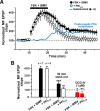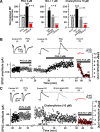Critical involvement of postsynaptic protein kinase activation in long-term potentiation at hippocampal mossy fiber synapses on CA3 interneurons
- PMID: 20181582
- PMCID: PMC2854556
- DOI: 10.1523/JNEUROSCI.5269-09.2010
Critical involvement of postsynaptic protein kinase activation in long-term potentiation at hippocampal mossy fiber synapses on CA3 interneurons
Abstract
Hippocampal mossy fiber (MF) synapses on area CA3 lacunosum-moleculare (L-M) interneurons are capable of undergoing a Hebbian form of NMDA receptor (NMDAR)-independent long-term potentiation (LTP) induced by the same type of high-frequency stimulation (HFS) that induces LTP at MF synapses on pyramidal cells. LTP of MF input to L-M interneurons occurs only at synapses containing mostly calcium-impermeable (CI)-AMPA receptors (AMPARs). Here, we demonstrate that HFS-induced LTP at these MF-interneuron synapses requires postsynaptic activation of protein kinase A (PKA) and protein kinase C (PKC). Brief extracellular stimulation of PKA with forskolin (FSK) alone or in combination with 1-Methyl-3-isobutylxanthine (IBMX) induced a long-lasting synaptic enhancement at MF synapses predominantly containing CI-AMPARs. However, the FSK/IBMX-induced potentiation in cells loaded with the specific PKA inhibitor peptide PKI(6-22) failed to be maintained. Consistent with these data, delivery of HFS to MFs synapsing onto L-M interneurons loaded with PKI(6-22) induced posttetanic potentiation (PTP) but not LTP. Hippocampal sections stained for the catalytic subunit of PKA revealed abundant immunoreactivity in interneurons located in strata radiatum and L-M of area CA3. We also found that extracellular activation of PKC with phorbol 12,13-diacetate induced a pharmacological potentiation of the isolated CI-AMPAR component of the MF EPSP. However, HFS delivered to MF synapses on cells loaded with the PKC inhibitor chelerythrine exhibited PTP followed by a significant depression. Together, our data indicate that MF LTP in L-M interneurons at synapses containing primarily CI-AMPARs requires some of the same signaling cascades as does LTP of glutamatergic input to CA3 or CA1 pyramidal cells.
Figures







Similar articles
-
Synapse-specific compartmentalization of signaling cascades for LTP induction in CA3 interneurons.Neuroscience. 2015 Apr 2;290:332-45. doi: 10.1016/j.neuroscience.2015.01.024. Epub 2015 Jan 28. Neuroscience. 2015. PMID: 25637803 Free PMC article.
-
Bidirectional Hebbian plasticity at hippocampal mossy fiber synapses on CA3 interneurons.J Neurosci. 2008 Dec 24;28(52):14042-55. doi: 10.1523/JNEUROSCI.4848-08.2008. J Neurosci. 2008. PMID: 19109487 Free PMC article.
-
PTP and LTP at a hippocampal mossy fiber-interneuron synapse.Proc Natl Acad Sci U S A. 2001 Dec 4;98(25):14708-13. doi: 10.1073/pnas.251610898. Proc Natl Acad Sci U S A. 2001. PMID: 11734656 Free PMC article.
-
Role of giant depolarizing potentials in shaping synaptic currents in the developing hippocampus.Crit Rev Neurobiol. 2006;18(1-2):13-23. doi: 10.1615/critrevneurobiol.v18.i1-2.30. Crit Rev Neurobiol. 2006. PMID: 17725505 Review.
-
Multiple forms of long-term synaptic plasticity at hippocampal mossy fiber synapses on interneurons.Neuropharmacology. 2011 Apr;60(5):740-7. doi: 10.1016/j.neuropharm.2010.11.008. Epub 2010 Nov 18. Neuropharmacology. 2011. PMID: 21093459 Free PMC article. Review.
Cited by
-
Calcium-Dependent Protein Kinase C Is Not Required for Post-Tetanic Potentiation at the Hippocampal CA3 to CA1 Synapse.J Neurosci. 2016 Jun 15;36(24):6393-402. doi: 10.1523/JNEUROSCI.0708-16.2016. J Neurosci. 2016. PMID: 27307229 Free PMC article.
-
The Role of mGlu Receptors in Hippocampal Plasticity Deficits in Neurological and Psychiatric Disorders: Implications for Allosteric Modulators as Novel Therapeutic Strategies.Curr Neuropharmacol. 2016;14(5):455-73. doi: 10.2174/1570159x13666150421003225. Curr Neuropharmacol. 2016. PMID: 27296640 Free PMC article. Review.
-
Differentially expressed three non-coding alternate exons at 5' UTR of regulatory type I beta subunit gene of mouse.Mol Biol Rep. 2012 Apr;39(4):3375-83. doi: 10.1007/s11033-011-1108-4. Epub 2011 Jun 26. Mol Biol Rep. 2012. PMID: 21706350
-
Presynaptic LTP and LTD of excitatory and inhibitory synapses.Cold Spring Harb Perspect Biol. 2012 Feb 1;4(2):a005728. doi: 10.1101/cshperspect.a005728. Cold Spring Harb Perspect Biol. 2012. PMID: 22147943 Free PMC article. Review.
-
Soluble Epoxide Hydrolase Inhibitor and 14,15-Epoxyeicosatrienoic Acid-Facilitated Long-Term Potentiation through cAMP and CaMKII in the Hippocampus.Neural Plast. 2017;2017:3467805. doi: 10.1155/2017/3467805. Epub 2017 Aug 24. Neural Plast. 2017. PMID: 29138698 Free PMC article.
References
Publication types
MeSH terms
Substances
Grants and funding
LinkOut - more resources
Full Text Sources
Miscellaneous
